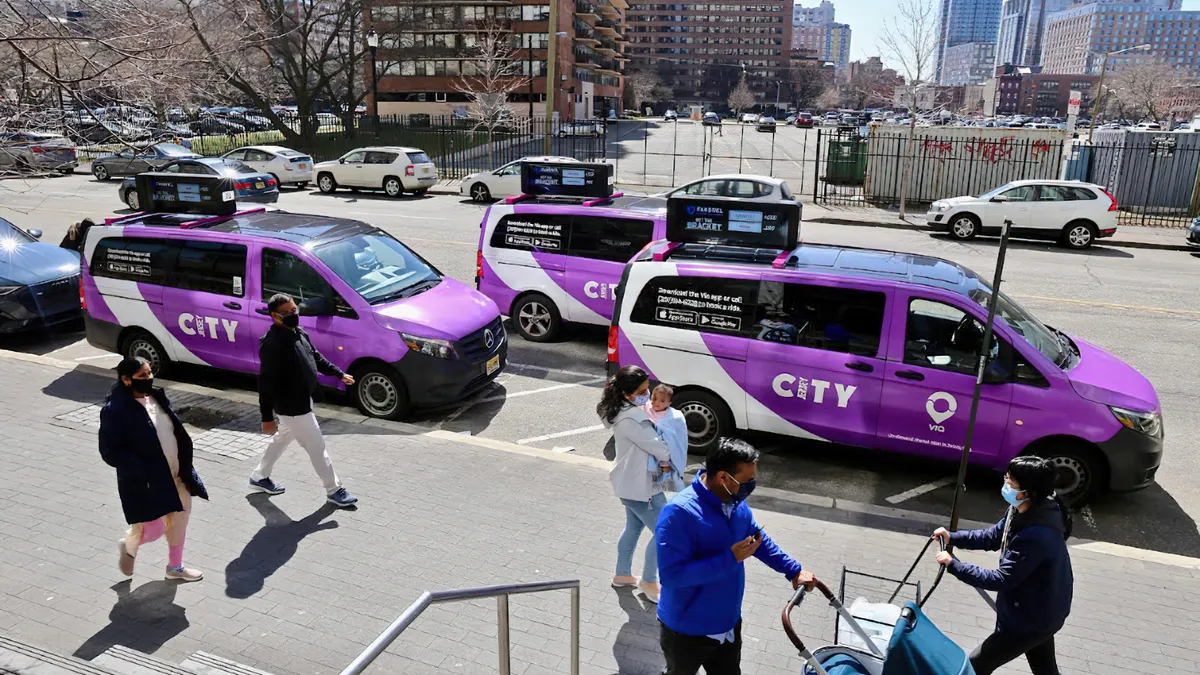More than 1 million rides have taken place since February 2020 using Jersey City, New Jersey’s on-demand microtransit system, a service model that is filling gaps in traditional public transportation networks among cities both large and small.
Ride-hailing vehicles, vans, shuttles and buses can all function as microtransit. They can be used on fixed or flexible routes and schedules, as well as with on-demand scheduling. Today, more than 100 on-demand microtransit systems are operating in about 40 states, according to Via, a company that provides cities and transit agencies with technology and service operations for on-demand public transportation, paratransit and non-emergency medical transportation.
In partnership with Via, Sacramento, California rolled out an app-based, on-demand shuttle service called SmaRT Ride in 2020 and expanded service last month for the city’s half-million residents. Pflugerville, Texas, a city of approximately 65,000 people, will begin a ride-sharing voucher program with Uber and Maruti on Oct. 1, with the city subsidizing a portion of the cost of the rides.
That’s also how Jersey City’s program works, said Barkha Patel, director of the city’s newly formed infrastructure department. The city contracted with Via in 2020 and is investing $7.5 million this year to support the service, keeping the cost to riders at $2.00 to $2.50 per ride, depending on the zone. Those fares are comparable to bus and light rail fares.
She described the service as a roaring success. “It continues to break ridership records month by month, quarter by quarter, year by year. It's just beyond anything that we would have expected in terms of travel patterns overall,” Patel said.
There are still “transit deserts” in the city, she said, even though Jersey City is served by New Jersey Transit light rail and buses, the Port Authority Trans-Hudson rail line to Manhattan and privately operated transit buses.
“More than half of our population uses transit to commute to work,” she explained. “But we still have areas of the city that, even if they had a bus line or some other form of transit, the quality of service was not up to par for what the residents were really needing.”
Of the Jersey City microtransit riders who reported their household income on a recent survey, more than half said their households earned less than $50,000. Other recent data showed that 40% of all rides began or ended within 300 feet of an affordable housing location. “The service continues to provide vital transportation for exactly the communities that it was intended to uplift,” said Jersey City Mayor Steven Fulop in an August press release.
“Microtransit is a great piece of a network when it's done in an integrated way that enables cities and agencies to drive overall ridership,” said Dillon Twombly, chief revenue officer at Via.
Several cities are working with Via to eliminate gaps in public transit. The Central Ohio Transit Authority, which serves Columbus, has operated on-demand transit since 2019 using buses and vans to make connections with fixed-route services. Miami-Dade Transit’s GO Connect has provided first- and last-mile transportation for two years. Birmingham, Alabama, operates an on-demand program with $1.50 rides, and the Green Bay, Wisconsin, Metro recently expanded its microtransit service.
Shared bicycles and scooters can also address temporary gaps in public transportation service. When the Massachusetts Bay Transportation Authority shut down a major subway line last month to make safety repairs, Boston’s Bluebikes bike-sharing program added 500 bikes and made free passes available.
Lyft, which operates extensive bike-sharing and shared scooter services in many cities around the U.S., said in its 2022 multimodal report that 89% of its riders used shared micromobility as a first- or last-mile connection to public transit last year, and a third of riders used shared micromobility when public transit was not available.
Microtransit options are also helping to reduce the reliance on personal cars. “We've received feedback from people who say that because of Via they are now more consistently leaving their personal vehicle at home and using Via instead to travel within the city, which is exactly the kind of thing we want to see happen,” said Jersey City’s Patel.












